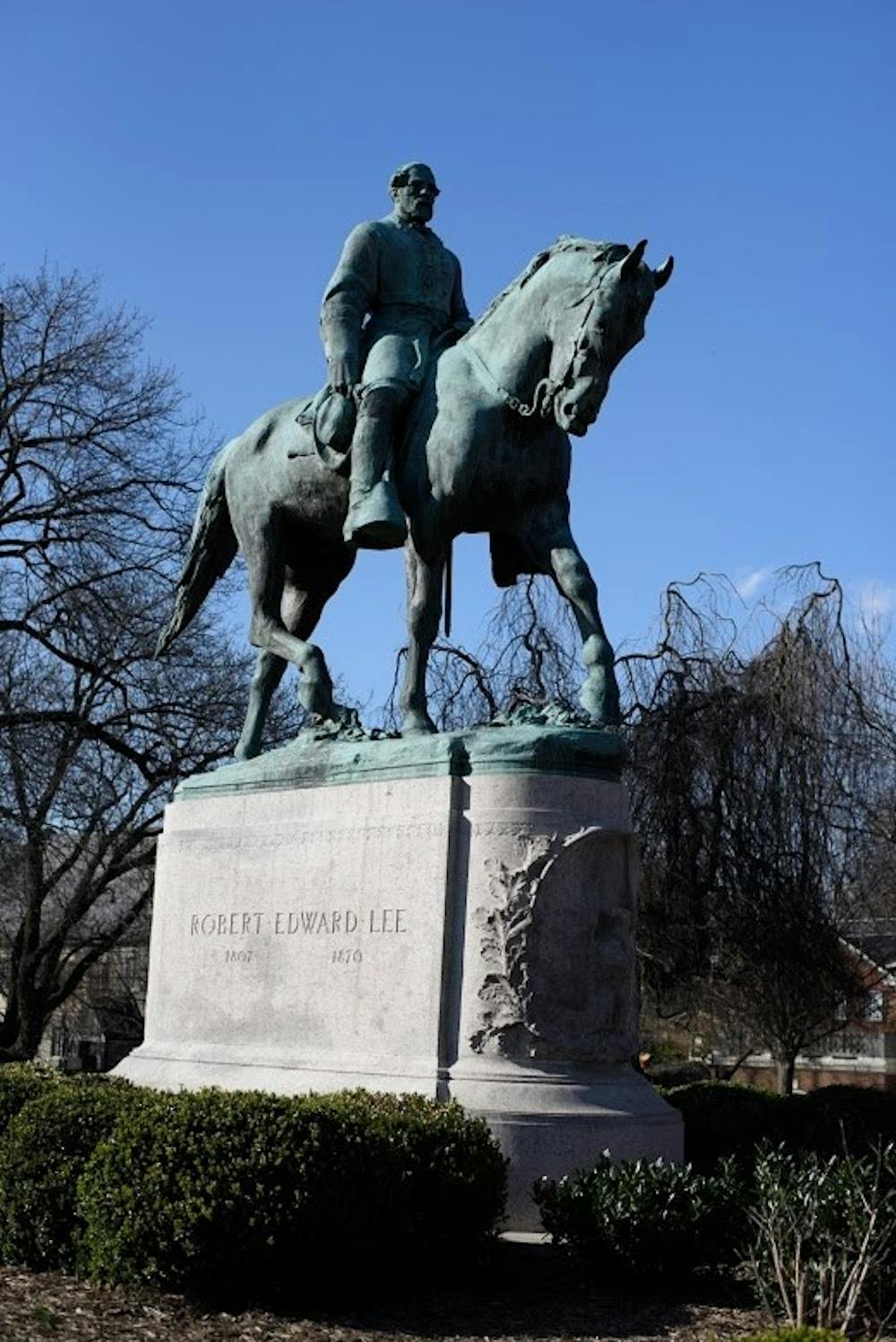After much debate, a City Council vote to decide the fate of the downtown Robert E. Lee statue in Lee Park ended in a deadlock Tuesday.
The discussion and vote came after the Blue Ribbon Commission’s report on how best to “provide council with options for telling the full story of Charlottesville’s history of race and for changing the City’s narrative through our public spaces.”
After hearing statements from concerned citizens and from each member of the council, the council members voted on Councilor Kristin Szakos’s motion to remove the statue of Lee — possibly relocating it to McIntire Park — and rename Lee Park. The vote resulted in a 2-2 tie, with one abstention among the five council members.
Szakos and Vice Mayor Wes Bellamy voted in favor of the proposal, and Councilor Kathy Galvin and Mayor Mike Signer voted against it, while Councilor Bob Fenwick abstained.
The decision was met with numerous cries of criticism from the audience, which seemed to be for the most part in favor of the statue’s removal. Signer was forced to remind the audience of the rules for contributing to the discussion, threatening to eject one audience member from the room for disrupting the meeting.
The discussion Tuesday was the result of a months-long project by the Blue Ribbon Commission to recommend a course of action on the city’s Confederate memorials, which came under considerable scrutiny last spring when Bellamy called for the removal of the Robert E. Lee statue from Lee Park near the Downtown Mall.
Two of the options the commission proposed were to remove the statue of Lee and possibly relocate it to McIntire Park, or to add contextualization in the form of another statue or an addition to the existing one to remind viewers of the entire complicated history tied to it.
At the meeting’s opening, several Charlottesville citizens spoke in favor of the statue’s removal.
Riley Doherty, a Charlottesville High School student, was among those who commented.
“We must remove these statues because they are a cultural embarrassment,” Doherty said.
Several others shared Doherty’s point of view. Community member Lyndsey Beutin, who also spoke out against the statue, said its message is one of “hostility and exclusion.”
However, resident John Hayden spoke out in favor of the statues. He claimed the majority of the public supported the statues and took issue with the cost of their removal.
Before voting, each member of the council explained their opinions on the matter. Fenwick began the discussion.
“At its core, this discussion concerns racism,” Fenwick said.
Fenwick went on to explain there are difficulties associated with each course of action laid out by the commission — including the cost associated with moving the statue — which he said could result in a tax increase for citizens.
Bellamy followed, speaking out strongly in favor of the statue’s removal. He discussed his personal experiences with racism as a result of his outspoken efforts to remove the statues and improve race relations in Charlottesville.
“I have received death threats. My daughters have been mentioned by name. I have been called every kind of n-word you can imagine,” Bellamy said. “If any of you believe that that is not in part because I am an African-American … then you are mistaken.”
Szakos firmly supported Bellamy’s points, and recommended not only removing the statue, but also renaming the park, as suggested by the commission.
“The work of the commission is going to change the way Charlottesville tells its story and repair the harm done by past injustices,” Szakos said.
Galvin, on the other hand, pointed out several challenges of the removal process.
“It has been estimated to cost $350,000 to move the Lee statue,” Galvin said, adding that she believed the estimate to be lower than the actual cost.
She went on to list several projects which would tangibly benefit from that funding, including new classrooms, parking spaces on West Main Street or the rehabilitation of houses through the Block by Block program.
She also argued the removal of the statue would represent an attempt to erase that chapter of history, rather than have members of the Charlottesville community learn from it. Instead of removing the statue, she urged council members to vote to contextualize it instead.
Signer then spoke, taking into account the complexity of the issue at hand.
“This is a very difficult and painful issue,” Signer said. “The question we have before us is how to address memorials that were put in place several decades after the abolition of slavery to celebrate the Confederacy.”
He noted the problems with removing the Lee statue, saying its relocation would only “replicate” the current issue. Instead, he supported Galvin’s argument to contextualize the memorial.
He suggested adding a new, more prominent statue to serve as a reminder of the painful racial history that accompanies Lee’s memory.
The tie vote, partially a result of Fenwick’s abstention, was met with considerable criticism and frustration from the audience.
“That’s basically the same, Mr. Fenwick, as a ‘no,’ in this case,” Szakos said.
Bellamy also disapproved, and although he attempted to convince Fenwick to vote in favor of the proposal, Fenwick could not be persuaded.
“Mr. Fenwick, you firmly believe that this will come around again, and you will vote on this issue at a later time, correct?” Bellamy asked.
“If certain things happen in our city, yes,” Fenwick answered.
Fenwick, Bellamy suggested, was simply tying the vote to gain leverage in negotiations over other proposals.
“It appears as if … this decision essentially is being held hostage, because you want to see other things move forward,” Bellamy said.
Fenwick refused to replace his abstention with a vote.
It remains to be seen if other recommendations by the commission will be taken up by City Council.





